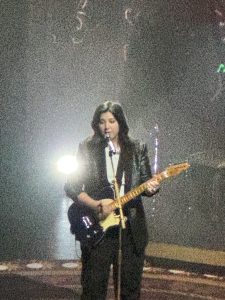Everything is pitch black. Then, a beam of light emerges from center stage. The five instrumentalists, consisting of percussion, violin, guitar, bass, and keyboard, walk through the light and get into position to the right and left. A short violin solo– clean as it cuts through a sea of reverb –called “Calliope Prelude” introduces the hour-and-a-half set list that is about to ensue.

The strings fade as Lucy Dacus quietly steps onto the stage at the Palace Theater on May 5. She wears a glittering black blazer, a second cue to the motif of light and darkness that resurfaces throughout the night. The crowd grows quiet as she lets out the first few lines of “Hot and Heavy,” a crowd favorite featured on her third album, “Home Video,” released in 2021. Unlike many of the songs on her newest album released in late March, “Forever is a Feeling,” the song has an intriguing body and build. It starts small, but with changing strumming patterns, breaks for silence, and a satisfying instrumental section that ultimately closes the song, by the end, the music alone tells a story of its own.
When “Ankles” begins next, Dacus gives the guitar a rest. Buoyant violin strings and a steadying bassline are refreshing after hours of acoustic and electric guitar from the opening performances with Katie Gavin and jasmine.4t. Her strong and focused alto voice sounds like another member of the string family, complemented pleasantly by the violin. Midway though, the percussion sets in and soon follows Dacus’s electric guitar. When she pulls away from the microphone, the crowd responds with cheer.
“Modigliani,” “Talk,” and “Big Deal,” all songs from the touring album, are next and there are few things that distinguish these songs from one another. Two of these songs have a playful start –a whistle or a single held note on the violin and bubbly staccato– but what follows becomes quickly calculable: the drums pick up, then pause, making way for a choral buildup that loses its impact over time. Meanwhile, melodical creativity is lacking with these songs. Dacus holds her notes dependably long and they fall close to the notes that rang before it.
While these songs are a slower section of the evening, the transitioning artwork behind Dacus is a strengthening supplement. At one point, six individual portraits, each depicting a different member of the band, project brightly in the dim background. Each one has a unique style: Dacus’s is a simple watercolor, the drummer’s is abstract that exaggerates different facial features, and the pianist’s is painted like a medieval queen.
Then, there is a dreamy night sky sprinkled with stars in the fourth and third to last songs (excluding encore), “Bullseye” and “Most Wanted Man.” Over the course of the song, constellations illustrate a collection of liminal objects like an archery bow, letter, playing card, and key and lock. The night sky fades and is replaced by window sills in the next song, “Lost Time.” The audience sees a cloudy gray sky emerge. And by the final anthem, “Forever is a Feeling,” the storm is gone. Sun beams pour through the windows and optimistic piano notes begin to stir. “This is bliss. This is hell. Forever is a feeling and I know it well,” Dacus sings.
Dacus begins the act with darkness and the narrative of a single violin. Then, she ends in bright light with a busy conversation of overlapping percussion, keys, bass, and voices. With a captivating vocal performance and carefully planned lighting, the few weaker musical moments are forgettable. Dacus sings a story of light.